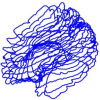Free Online Productivity Tools
i2Speak
i2Symbol
i2OCR
iTex2Img
iWeb2Print
iWeb2Shot
i2Type
iPdf2Split
iPdf2Merge
i2Bopomofo
i2Arabic
i2Style
i2Image
i2PDF
iLatex2Rtf
Sci2ools
100
Voted
ICCV
2007
IEEE
2007
IEEE
Modeling Brain Anatomy with 3D Arrangements of Curves
We employ 3D arrangements of curves to represent and analyze biological shapes, in particular, the anatomy of the human brain. The arrangements of curves may vary from fairly sparse ? such as a collection of sulcal lines that coarsely approximates the global shape of the brain ? to very dense decompositions of the cortical surface into space curves. A space of shapes of such arrangements is constructed equipped with geodesic metrics that can be used in conjunction with curve registration techniques to quantify shape resemblance or dissimilarity, as well as to identify the regions where anatomical differences are most pronounced. The metric is applied to the parcellation and labeling of configurations associated with the left and right hemispheres of the brain. Examples are also given of geodesic interpolations between decompositions into space curves of surfaces representing the entire left hemisphere of the brain.
Computer Vision | Dense Decompositions | Entire Left Hemisphere | Geodesic Metrics | Human Brain | ICCV 2007 | Space Curves |
Related Content
| Added | 14 Oct 2009 |
| Updated | 30 Oct 2009 |
| Type | Conference |
| Year | 2007 |
| Where | ICCV |
| Authors | Washington Mio, John C. Bowers, Monica K. Hurdal, Xiuwen Liu |
Comments (0)

